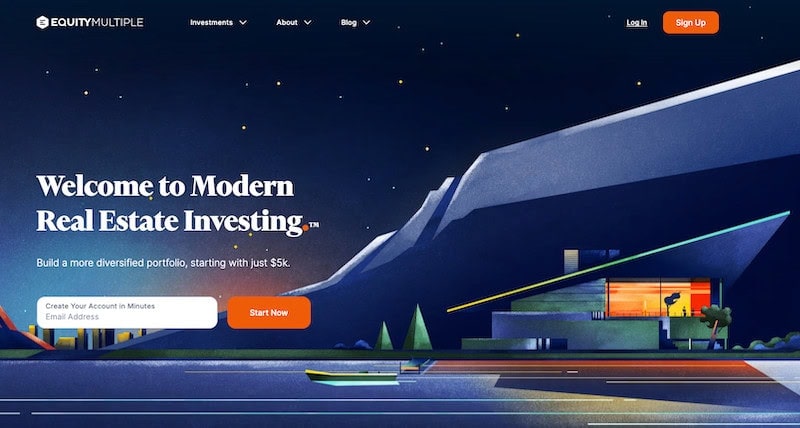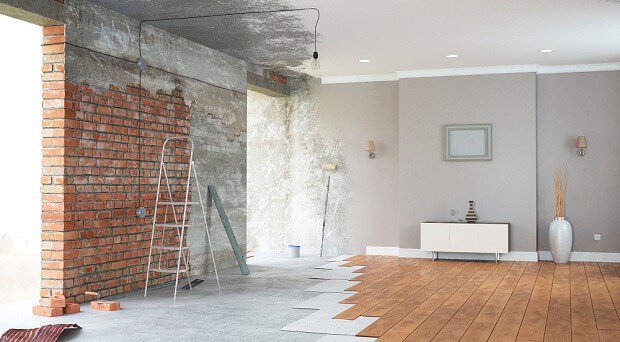Investing in real estate is one of the best ways to achieve financial independence. But that doesn’t mean it’s easy to get from point A to point B.
How do you decide in which properties to invest? Where do you get the money? And, just as important, how do you build your portfolio once you have taken care of that initial investment? You need a strategy — especially if you’re just starting out as an investor. The BRRRR Method is just that: a specific, tested, and sustainable investment strategy that can get you from point A to point B and beyond.
Let’s break it down, step by step, and compare it to some other popular investment strategies.
Table of Contents
How Does the BRRRR Strategy Work?

BRRRR stands for “Buy, Repair, Rent, Refinance, and Repeat.” This real estate investing method describes a strategy and framework used by investors who have the desire to build passive income streams over time through collecting rents from tenants and building equity in properties.
The specific steps involved in the BRRRR strategy include:
- Buy: Purchase an undervalued asset that appreciates in value using a hard money loan
- Repair: Renovate and improve the property to max out its value and make it tenant-ready
- Rent: Turn the property into a income-generating asset by renting it out at market rates
- Refinance: Use a cash-out refinance to pay off your initial hard money loan with enough money left over for a down payment on a new property
- Repeat: Do it all over again with a second (and third and fourth) property
That’s the BRRRR method in a nutshell, although it’s not as simple as it may sound. Buying real estate acts as one of the best investments for young adults because it stores value in a non-market correlated fashion, appreciates in value and generates cash flows across long periods of time.
Personally, I’ve purchased two rental properties and rented them for positive cash flow.
At some point, I may want to expand on these holdings and would consider the BRRRR Method. For those interested in building a sizable investment real estate portfolio, let’s look at each step in more detail.
The video below provides a high-level overview while the article provides greater explanation and detail.
1. Buy

Looking for undervalued properties becomes an essential step for any wise investment, but it remains especially important when it comes to the BRRRR method. This holds true for two reasons.
First, because these property values come below market, you can boost their value with reasonably priced renovations. The more you can up the property’s value, the more equity you’ll have to cash in during step 4 — the cash out refinance.
Second, you seek out undervalued properties because, unless you already have a lot of capital on hand, you’ll want to finance this buy with a hard money loan. A hard money loan comes from a private, non-bank lender, and the process for getting one is a lot different, and simpler, than getting a bank loan.
When you request a loan from a bank, the primary factor in its decision is going to be your creditworthiness; with a hard money loan, the property acts as the collateral. That means the bank will just look at the investment value of the property. If it’s a good investment, you’ll get your loan. Therefore, you’ll need to make a strong case for yourself.
Of course, certain drawbacks exist for using hard money. Although the approval process comes at a faster pace and with a simpler application than a bank loan, hard money loans come with an interest rate that often carries a higher level than would a conventional mortgage.
Hard money loans can carry an interest rate as high as 15%, with a range of 7.5% to 15%. These loans also come with a slightly lower loan-to-value (LTV) ratio than a conventional loan as well as a shorter repayment term, usually one to three years.
Hard money loans count as short-term money, used mainly by BRRRR investors and house-flippers. In fact, the first two steps of BRRRR essentially use the house-flipper formula, without the “flip.”
With that in mind, one good way to make sure you look at a quality investment includes using the house-flipping standby, the “Rule of 70%.” The Rule of 70% states that you shouldn’t pay more than 70% of a property’s after-repair value (ARV), minus repair costs. In real terms, that means that if you look at an investment property with an ARV of $200,000 that needs $40,000 in repairs, you should pay no more than $100,000 for the property.
Although this doesn’t serve as an ironclad rule, it makes good financial sense. In the case above, after you spend $40,000 on repairs, you’ll still have $60,000 of breathing room to absorb cost overruns, market fluctuations or other unforeseen complications.
Related: 11 Best Fidelity Funds to Buy
2. Renovate
Once you’ve bought your property, you’ll have a good idea of how much you can afford to spend on repairs, as well as what specific repairs you’ll need. The difficulty here arises in two ways:
First, you’ll need to find a contractor who can perform those repairs competently and within your budget. That can be harder than it sounds. By the time you’re rehabbing your fourth or fifth or tenth property, you’ll have found people you can trust. But in the beginning, it can be challenging. If you know other investors, ask for referrals.
Second, every day you own the property costs you money. These carrying costs include utilities, property taxes and even loan payments. So even if your repairs come in under budget, if they take longer than scheduled, that can cost you extra money, too.
As for what repairs you should undertake, there are a lot of great guides to what home repairs have the best return on investment.
3. Rent

If you were a house-flipper, this is the point where you’d sell your home. But with the BRRRR method, it’s time to turn it into a cash flow-generating asset. That means renting it out. Renting out the property is your endgame for the property, so that means in your initial buying process, you should evaluate the property as a rental.
For the BRRRR method, a property in a great, active rental market comes as a preferable choice to one that may be slightly more undervalued but carries less attractiveness to renters. For example, think of a condo or apartment near a university, which will have a constant amount of demand versus a suburban property in a cul-de-sac that might have more raw value but is located in a market more geared to buyers.
Also keep in mind that any time your rental property doesn’t have a tenant, the costs essentially eat a hole in your pocket.
Research vacancy rates when you consider properties and screen your tenants carefully. When you run projections, don’t forget to take property management fees into account — these can usually amount to around 10% of rents collected.
4. Refinance

Here’s where the BRRRR method really shows its value. Once your property has been renovated and rented, you can proceed with a cash-out refinance, which basically converts the home’s equity into cash.
Cash-out refinances can free up some cash, but they also have a lot of other advantages as well. You’ll get a much better interest rate on a cash-out refinance than you would on a home equity loan or a home equity line of credit (HELOC), much less another hard money loan. And you can deduct the interest on your taxes.
With your cash-out refinance, you can settle your initial loan and use the cash for the next step.
Related: Best Debit Cards for Teens to Become Money Savvy
5. Repeat

The cash from the previous step would make a perfect down payment on another property. And this time, you’ll have experience under your belt, a growing network of contractors and a cash-generating rental property.
With careful planning, you could use the BRRRR method to build a sizable portfolio of rental properties; the sky’s the limit.
It’s not easy — if it were, everyone would have half a dozen rental properties. It takes a lot of careful research and planning on the front end; the initial step — the purchase — has outsized importance compared to the other steps. But if you get that right, the rest of the puzzle can fall into place.
In the end, the BRRRR method is the only real estate investment strategy that can take you from no money down on your first investment to a healthy portfolio of cash-generating rentals in less than a decade. The sooner you get started, the sooner you can realize your investment dreams.
Related: Best Debit Cards for Kids
Alternatives to the BRRRR Method
The BRRRR Method shows a considerable amount of return potential, though with a significant amount of time, energy and investment- both financial and personal. The method has helped many real estate investors rapidly build their investment holdings.
For those interested in building their own portfolio but may have reservations about the risks involved, you can conduct parts of the method in isolation. In particular, you now have access to alternative investment options like crowdsourced real estate funding apps. These apps vary with their investment objectives, but each can provide access to retail investors interested in different parts of the BRRRR Method.
To understand the opportunities available to you, please review the following services to see if they make sense for your broader investment portfolio. Signing up for each one is free and a great way to learn more.
How to Invest in Crowdsourced Real Estate
Many services target different investing objectives, risk preferences and income segments. Have a look at three leading crowdsourced real estate investing platforms and what types of investment they offer.
How to Buy Crowdsourced Real Estate
→ Investing in Individual Properties (EquityMultiple)

Some platforms like EquityMultiple allow you to invest in individual properties, specifically commercial real estate. Others, as discussed below, allow you to invest in real estate property portfolios.
EquityMultiple carries a minimum $5,000 initial investment on most opportunities and comes with a limitation on the type of investors who can participate.
Namely, EquityMultiple only allows its individual commercial real estate projects to receive investments from accredited investors, discussed more below.
Accredited Investors: While this definition recently changed, from one which usually meant high-net worth/high-income individuals, to now one which focuses on investor experience and knowledge, it typically skews more towards investors with financial wherewithal and familiarity. That said, the new amendments from the SEC allow investors to qualify as accredited investors based on defined measures of professional knowledge, experience or certifications in addition to the existing tests for income or net worth.
These tests for financial resources include having an aggregate net worth of over $1,000,000 and earning over $200,000 in each of the two most recent years or joint income with that person’s spouse in excess of $300,000 in each of those years with a reasonable expectation of reaching the same income level in the current year.
For those interested in learning more about EquityMultiple, consider signing up for an account and going through their qualification process.
- EquityMultiple is a commercial real estate platform for accredited investors, providing investment opportunities in real estate funds, individual properties, and savings alternatives.
- EquityMultiple has a team boasting decades of real estate transaction experience. Their due diligence process whittles down a large selection of properties, accepting only 5% as target investments that they use to build a variety of portfolios that suit numerous investing objectives.
- The company has made $379 million in distributions since its founding.
- Makes commercial real estate Investments accessible
- Intuitive website design
- High net total returns and distributions paid to investors
- Only available to accredited investors
- High investment minimum to begin
- Fee structure varies by investment, complex at times
→ Investing in Real Estate Portfolios (Fundrise)
While EquityMultiple focuses on investing in individual real estate properties, other companies focus on investment in real estate portfolios, or several properties in one investment. In theory, this diversifies your investment risk while providing you access to several properties simultaneously.
Fundrise is a popular real estate investing platform that allows you to diversify through its numerous funds. Each fund holds a number of properties and is designed to provide varying levels of risk and income.
Among its options:
- Starter and Basic accounts: Investors can now access Fundrise for as little as $10. People who open a Starter account ($10-plus minimum investment) or Basic account ($1,000-plus) have their money automatically invested in the Flagship Real Estate Fund, which seeks a balanced objective of income and growth.
- Core, Advanced, and Premium accounts: Core ($5,000-plus), Advanced ($10,000-plus), and Premium ($100,000-plus) accounts all have access to more specialized strategies. The four primary funds, from low risk/income to high risk/income, are Fixed Income, Core Plus, Value Add and Opportunistic. These accounts also have varying amounts of access to Fundrise’s “eREITs.” Also, Advanced and Premium accounts may invest in the Fundrise eFund, which is a tax-efficient partnership that can also hold non-REIT-eligible assets with “unique potential.”
- Fundrise iPO: This “internet public offering” allows investors to buy a stake in Fundrise’s parent company, Rise Companies Corp.
- Innovation Fund: This fund does not invest in properties, but rather private high-growth technology companies. While the fund expects to focus primarily on late-stage companies, it can hold early- and late-stage private companies, as well as some public equities. (Fundrise would likely invest in these publicly traded companies prior to their IPO, or initial public offering.)
You do not need to be an accredited investor to invest in Fundrise, but several of its funds are closed to non-accredited investors.
Fundrise does share one thing in common with traditional commercial real estate investing, however: It can be highly illiquid. Fundrise itself states that “the shares you own are intended to be held long-term.” You can incur a penalty for selling any eREIT and eFund shares held for less than five years, for instance. Also, you can’t pick and choose what you sell—Fundrise’s “first in first out” system means that when you liquidate, the first shares sold will be those you’ve held the longest.
Even then, commercial real estate remains one of the best alternative investments you can own, and Fundrise helps people easily reap its rewards. Like with owning shares of publicly held real estate, private CRE price returns will often lag a major index like the S&P 500. But the passive income from real estate investing is nice: Since 2017, Fundrise’s average annual income return of 5.29% dwarfs that of both public real estate investment trusts (REITs, 4.1%) and the S&P 500 (2.0%). That includes a 1.5% total return (price plus dividends) in 2022 compared to double-digit losses for public REITs and the S&P 500.
Most of Fundrise’s real estate funds charge an annual 0.85% flat management fee. The Fundrise Innovation Fund, which provides access to venture capital-style investments, charges 1.85% annually.
Visit Fundrise to learn more about this alternative asset class or sign up today.
- Regardless of your net worth, you can now benefit from real estate’s unique potential for generating consistent cash flow and long-term gains with Fundrise starting as low as $10.
- Enjoy set-it-and-forget-it managed portfolios with standard Fundrise accounts, or actively select the funds you want to invest in with Fundrise Pro.
- Diversify your portfolio with real estate, private tech investing, or private credit.
- Low minimum investment ($10)
- Accredited and non-accredited investors welcome
- IRA accounts available
- Highly illiquid investment
Related: 11 Best Fundrise Alternatives [Accredited & Non-Accredited Apps]
Investing in Renovation Opportunities
→ Investing in Rental Real Estate Renovations (Groundfloor)
Groundfloor is a different type of investment platform from the two others listed above. Instead of taking an ownership interest in those properties (though EquityMultiple does also offer some debt investment opportunities), Groundfloor acts as a crowdsourced real estate investing platform focused on debt investments.
The platform focuses on purchasing fixer-uppers, performing the maintenance and upgrades, and then flipping them for a profit. Groundfloor provides financing for short-term residential real estate loans and pays the platform’s investors interest.
The service reviews loan applications submitted by flippers and offers investors the ability to fund notes it believes will perform. In exchange, investors receive a set amount of interest from their loan as well as a return of principal. Most loans have a 6-12 month term, but some can extend to 18 months.
- Groundfloor is a crowdsourced real estate investing platform which offers high-yield, short-term real estate debt investments.
- Offers collateralized, secured real estate debt with 1-month, 3-month, and 12-month terms.
- Has delivered consistent 10%+ returns over past eight years with repayments received in 6-9 months on average.
- Offers after-tax and IRA investment options.
- Special offer: When you sign up with our link, create your account and transfer your first $100, you'll receive a $100 credit to invest on Groundfloor.*









![10 Financial Gifts for Babies, Kids & Grandkids [No More Toys] 26 best financial gifts children kids babies](https://youngandtheinvested.com/wp-content/uploads/best-financial-gifts-children-kids-babies-600x403.jpg)
![7 Best Investments for Kids [Investing for Children] 27 best investments for kids 1](https://youngandtheinvested.com/wp-content/uploads/best-investments-for-kids-1-600x403.jpg)

